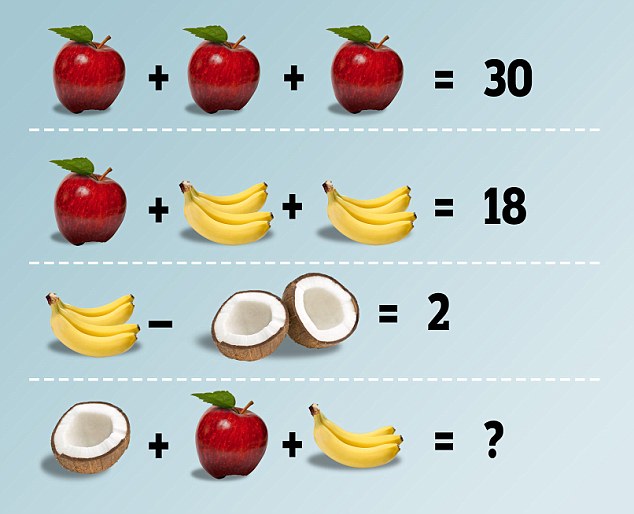当前位置: Language Tips> 双语新闻
Can you solve the 'simple' brainteaser?

A "simple" brainteaser for children has sparked an online debate, with many adults arguing about what the correct answer is.
一个看似简单的儿童谜语近日在网上引发热论,很多成年人为正确答案到底是什么争论不休。
The apples, bananas and coconuts conundrum is being widely shared online, leaving some puzzle solvers perplexed.
这道“苹果香蕉椰子谜题”在网上疯传,很多参与者为它“烧脑”。
Problem solvers must work out which number each fruit piece symbolizes in order to crack the brainteaser.
为了获得最终结果,解题者必须找出这三种水果各自代表的数字。
Internet users have been arguing that the answer to the final equation is anything from 14, 15, 16 to 20.
网友们都认为,最后那个等式的结果肯定是从14、15、16和20中选。
The Problem Site explains:
“解题网”给出的解释如下:
3 apples = 30, so 1 apple = 10.
3个苹果= 30,所以1个苹果= 10。
10 + 2 bananas = 18, so 2 bananas = 8 and 1 banana = 4
10 + 2串香蕉= 18,所以2串香蕉= 8,所以1串香蕉= 4。
4 - 1 coconut = 2, so 1 coconut = 2
4 - 1个椰子= 2,所以1个椰子= 2。
Therefore, 1 coconut + 1 apple + 1 banana = 2 + 10 + 4 = 16
因此,1个椰子+1个苹果+1串香蕉= 2 + 10 + 4 = 16。
However, if you look a little closer at the problem you will see that 16 is not the right answer.
不过,如果你再认真看一下原题就会发现,16并不是正确答案。
“Although this is the answer everyone seems to be giving, it's actually not correct. Notice that each bunch of bananas has four bananas (look closely!) except the one in the final line, which has 3 bananas. Also notice that the third line has one coconut, while the last line has only 1/2 of a coconut,” The Problem Site adds. “This changes things!”
“解题网”称:“虽然大家给出的似乎都是这个答案,但其实它并不对。你应该注意到,前面的每串香蕉上都有四只香蕉(看仔细哦!),但最后一个等式上的那串却只有三只香蕉。而且,第三个等式上有一个椰子,而最后一个等式上只有半个椰子。所以结果就不同了!”
3 apples = 30, so 1 apple = 10.
3个苹果= 30,所以1个苹果= 10。
10 + 8 bananas = 18, so 8 bananas = 8 and 1 banana = 1
10 + 8只香蕉= 18,所以8只香蕉= 8,1只香蕉= 1。
4 - 1 coconut = 2, so 1 coconut = 2
4 - 1只椰子为2,所以1只椰子= 2。
Therefore, 1/2 coconut + 1 apple + 3 bananas = 1 + 10 + 3 = 14
所以,半个椰子+1个苹果+ 3只香蕉= 1 + 10 + 3 = 14。
So there you have it, 14 is the right answer.
最终答案也出来了,应该为14。
Or is it? Dr Kevin Bowman, course leader for Mathematics at the University of Central Lancashire, told Mail Online that due to the ambiguity of the riddle, “there are an infinite amount of possible answers”.
不过,你真的确定了吗?中央兰开夏大学数学系的教学组长凯文·鲍曼博士告诉《每日邮报》,对这条谜语可以有多种解读,“所以其实它的答案是开放的。”
英文来源:每日电讯报
编译:杜娟
上一篇 : 奥巴马:特朗普不可能当总统
下一篇 : 苹果机设成这个时间会变砖
关注和订阅


电话:8610-84883645
传真:8610-84883500
Email: languagetips@chinadaily.com.cn